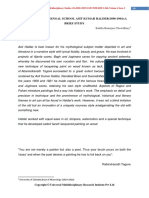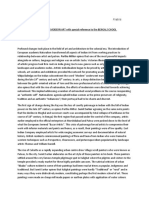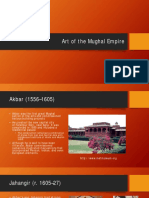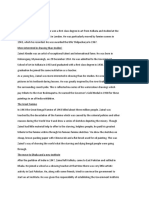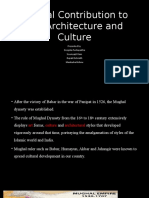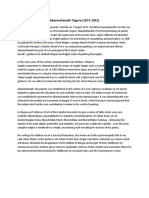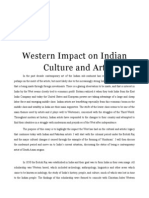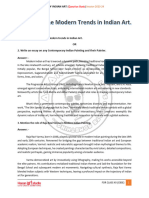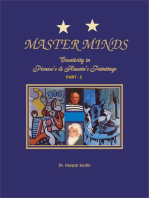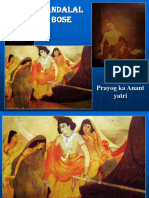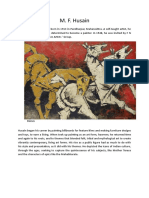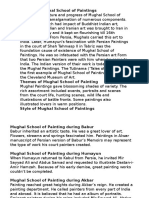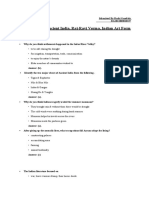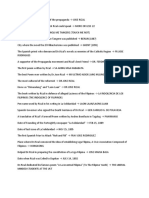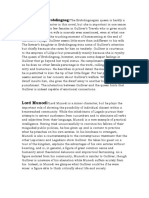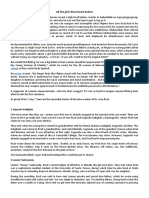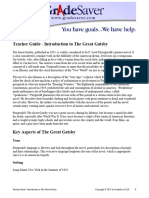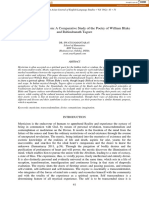Assignment-8 Paintings by The Artists Belonging To The Nationalist School of Bengal Art
Uploaded by
Rashi GambhirAssignment-8 Paintings by The Artists Belonging To The Nationalist School of Bengal Art
Uploaded by
Rashi GambhirSRM INSTITUTE OF SCIENCE AND TECHNOLOGY
DEPARTMENT OF COMPUTER SCIENCE AND ENGINEERING
18LEM110L – INDIAN ART FORM
REG NO: RA1811003010227 NAME: Rashi Gambhir
ASSIGNMENT-8
Paintings by the artists belonging to the Nationalist
School of Bengal Art.
The Bengal School of Art commonly referred as Bengal School, [1] was an art movement
and a style of Indian painting that originated in Bengal, primarily Kolkata and
Shantiniketan, and flourished throughout the Indian subcontinent, during the British Raj
in the early 20th century. Also known as 'Indian style of painting' in its early days, it was
associated with Indian nationalism (swadeshi) and led by Abanindranath Tagore (1871-
1951), but was also promoted and supported by British arts administrators like E. B.
Havell, the principal of the Government College of Art, Kolkata from 1896; eventually it
led to the development of the modern Indian painting.
Originating in Calcutta and Shantiniketan, the Bengal School of Art promoted a
distinctly Indian modernism which blossomed throughout India during the British Raj
of the early 20th century. By synthesizing folk art, Indian painting traditions, Hindu
imagery, indigenous materials and depictions of contemporary rural life, artists of the
Bengal School of Art celebrate humanism and bring a dynamic voice to Indian
identity, freedom, and liberation. Ahead of Sotheby's Modern & Contemporary South
Asian Art sale (18 March, New York) discover more about this formative artistic
movement.
1. The Bengal School grew out of swadeshi.
In the early part of the 20th century, Indian nationalist leaders promoted the concept of
swadeshi, a movement of self-reliance in the face of British colonization that was
specifically effective in the province of Bengal. Swadeshi called for social, cultural,
political – and most ardently economic – reforms that would break India from the
clutches of British rule. Boycotts of British manufacturers were organized in favour of
domestic and local products, which would invigorate Indian industry; cultural movements
were to dispose of British or Western literature and visual arts, and to produce works of
uniquely Indian qualities, turning to Hindu themes and ancient Indian painting styles.
SRM INSTITUTE OF SCIENCE AND TECHNOLOGY
DEPARTMENT OF COMPUTER SCIENCE AND ENGINEERING
18LEM110L – INDIAN ART FORM
REG NO: RA1811003010227 NAME: Rashi Gambhir
NINDRANATH TAGORE, UNTITLED (KATLA FISH) . ESTIMATE $20,000–
30,000 IN SOTHEBY'S MODERN & CONTEMPORARY SOUTH ASIAN ART
SALE (18 MARCH, NEW YORK) .
2. The Bengal School was a form of resistance that gave rise to Indian nationalism.
During the British Raj, when the British crown ruled the Indian subcontinent from 1858
to 1947, traditional Indian painting conventions and styles had fallen out of popularity,
largely because they did not appeal to the tastes of British collectors. In addition to the
European painting techniques and subjects that were taught in artistic academies,
Company Paintings were widely promoted, which catered to British sensibilities.
Company Paintings presented Indian subjects of indigenous plant life or traditional garb
and rituals, through both the European gaze and conventions of painting. Rather than
celebrating Indian cultural traditions, it simplified them into exotica. The Bengal School
arose to counteract such imagery, by turning to Mughal influences, and Rajasthani and
Pahari styles that presented elegant scenes of distinctly Indian traditions and daily life.
SRM INSTITUTE OF SCIENCE AND TECHNOLOGY
DEPARTMENT OF COMPUTER SCIENCE AND ENGINEERING
18LEM110L – INDIAN ART FORM
REG NO: RA1811003010227 NAME: Rashi Gambhir
MUKUL DEY, MK GANDHI, SABARMATI . ESTIMATE $1,000–2,000
SOTHEBY'S MODERN & CONTEMPORARY SOUTH ASIAN ART SALE (18
MARCH, NEW YORK).
3. There were contemporary British supporters of the Bengal School.
Although the Bengal School was a direct refusal of British artistic traditions, one of its
major founders was Ernest Binfield Havell, an English art historian, teacher, arts
administrator, and author. Havell urged his students to turn to Mughal miniatures as
influence rather than British models of production. While principal of the Government
School of Art in Calcutta, Havell helped founding artists of the Bengal School such as
Abanindranath Tagore and his sister Sunayani Devi fully develop the tenets and style of
the movement and promote its dissemination through educational systems.
SRM INSTITUTE OF SCIENCE AND TECHNOLOGY
DEPARTMENT OF COMPUTER SCIENCE AND ENGINEERING
18LEM110L – INDIAN ART FORM
REG NO: RA1811003010227 NAME: Rashi Gambhir
NANDALAL BOSE, UNTITLED (PREPARATORY SKETCH OF CHARLES
FREER ANDREWS) . ESTIMATE $3,000–5,000 IN SOTHEBY'S MODERN
CONTEMPORARY SOUTH ASIAN ART SALE (18 MARCH, NEW YORK).
SRM INSTITUTE OF SCIENCE AND TECHNOLOGY
DEPARTMENT OF COMPUTER SCIENCE AND ENGINEERING
18LEM110L – INDIAN ART FORM
REG NO: RA1811003010227 NAME: Rashi Gambhir
4. Bengal School Artist Nandalal Bose shared a special relationship with Gandhi.
Nandalal Bose, pupil of the Bengal School’s leader Abanindranath Tagore, became one
of the movement’s major artists. Exasperated by the British treatment of Indian
painting traditions, history, and artists, Bose turned to swadeshi notions of developing a
distinctively Indian modern art. He turned to the murals of Ajanta, and produced scenes
from Indian mythology and contemporary daily village life. In the 1920s and 30s, he
developed a friendship and professional relationship with Gandhi, who often invited
him to produce works for political pavilions. Bose commemorated Gandhi’s 1930
twenty-six day Dandi March with a series of sketches presenting him as a humble but
strong hero using expressive line work. These images of Gandhi contributed to the
development of twentieth century Indian modernism, identity, and nationalism.
SRM INSTITUTE OF SCIENCE AND TECHNOLOGY
DEPARTMENT OF COMPUTER SCIENCE AND ENGINEERING
18LEM110L – INDIAN ART FORM
REG NO: RA1811003010227 NAME: Rashi Gambhir
5. Asit Kumar Haldar was a major artist of the Bengal Renaissance.
Asit Kumar Haldar was the nephew of Abanindranath Tagore, major Bengal poet,
musician, and artist. He studied painting under Jadu Pal and Bakkeswar Pal, two leading
Bengal artists, and joined Nandalal Bose to document the Ajanta cave paintings and
frescoes from 1909 to 1911. Haldar’s works synthesize Buddhist art with Indian history
through a sense of idealism. He was the first Indian artist to be appointed as the principal
of a Government Art School, and was the first Indian to be elected a Fellow of the Royal
Society of Arts, London, in 1934. In addition to his artistic production and poetry, Haldar,
like his fellow artists of the Bengal Art School, committed his life to social reforms and
educational programs that would build a sense of Indian nationalism for contemporary
and future generations.
Bengal continues to produce some of the best artists of modern India. There is a
department in the Government College Of Art & Craft that has been training students the
traditional style of tempera and wash painting for almost a century now. These students
are carrying the legacy of the Bengal School artists, who, initially, were a group of artists,
following Abanindranath's style and sharing his aesthetic vision. Among them,
Dhirendranath Brahma is the living legend of the Bengal School of Art. He is a master of
calligraphy and has innumerable students who are carrying on the tradition of Bengal
School of painting. Among the other renowned artists of this style of painting are Amit
Sarkar, Ajoy Ghosh, Sankarlal Aich, Amal Chaklader, Narendranath De Sarkar, Sukti
Subhra Pradhan and Ratan Acharya. Some of the best known artists of present-day
Bengal are Jogen Chowdhury, Mrinal Kanti Das, Gopal Sanyal, Ganesh Pyne, Manishi
Dey, Shanu Lahiri, Ganesh Haloi [7] Jahar Dasgupta, Samir Aich, Bikash Bhattacharjee,
Sudip Roy, Ramananda Bandopadhyay and Devajyoti Ray. Sanat Chatterjee is one of the
last living pioneers of Bengal School of art. He studied under Asit Kumar Haldar for
around fifteen years.
You might also like
- R. Siva Kumar - Santiniketan - The Making of A Contextual Modernism (1997)No ratings yetR. Siva Kumar - Santiniketan - The Making of A Contextual Modernism (1997)28 pages
- Dilip Menon - Review of Sanjukta Sunderason Partisan Aesthetics Modern Art and India's Long DecolonizationNo ratings yetDilip Menon - Review of Sanjukta Sunderason Partisan Aesthetics Modern Art and India's Long Decolonization3 pages
- The Three Perfections of Ancient China Art - Art History Book | Children's Art BooksFrom EverandThe Three Perfections of Ancient China Art - Art History Book | Children's Art BooksNo ratings yet
- 12th_chapter 7 | The Modern Indian Art (Abstraction)No ratings yet12th_chapter 7 | The Modern Indian Art (Abstraction)35 pages
- THE "CALCUTTA GROUP" (1943-1953) Sanjoy MallikNo ratings yetTHE "CALCUTTA GROUP" (1943-1953) Sanjoy Mallik14 pages
- Abstraction in Modern Indian Art: A Study in The Post-Independence INDIAN PAINTING (1955-2005)No ratings yetAbstraction in Modern Indian Art: A Study in The Post-Independence INDIAN PAINTING (1955-2005)14 pages
- Mughal Contribution To Art, Architecture and CultureNo ratings yetMughal Contribution To Art, Architecture and Culture20 pages
- Indian Artist S. H. Raza: Mohammad AshrafNo ratings yetIndian Artist S. H. Raza: Mohammad Ashraf30 pages
- Calcutta Progressive Group (1943-53) : Modern Artists India KolkataNo ratings yetCalcutta Progressive Group (1943-53) : Modern Artists India Kolkata30 pages
- Master Minds: Creativity in Picasso's & Husain's Paintings (Part - 2): 1, 2, 3, 4, 5, #2From EverandMaster Minds: Creativity in Picasso's & Husain's Paintings (Part - 2): 1, 2, 3, 4, 5, #2No ratings yet
- Two Pioneering Women Artists - Clare HarrisNo ratings yetTwo Pioneering Women Artists - Clare Harris40 pages
- Gaganendranath Tagore: Name of Artwork, YearNo ratings yetGaganendranath Tagore: Name of Artwork, Year8 pages
- Pradosh Das Gupta Sculpture E-CatalogueNo ratings yetPradosh Das Gupta Sculpture E-Catalogue22 pages
- The Birth and Evolution of Modern Indian Art100% (1)The Birth and Evolution of Modern Indian Art2 pages
- Kanwal Krishna, Who Is Best Remembered For His Landscapes of The Himalayas, - 20240410 - 094812 - 0000No ratings yetKanwal Krishna, Who Is Best Remembered For His Landscapes of The Himalayas, - 20240410 - 094812 - 00007 pages
- [Ebooks PDF] download (Ebook) Shakespeare and Indian Cinemas: "local Habitations" by Poonam Trivedi; Paromita Chakravarti ISBN 9781138946927, 1138946923 full chapters100% (1)[Ebooks PDF] download (Ebook) Shakespeare and Indian Cinemas: "local Habitations" by Poonam Trivedi; Paromita Chakravarti ISBN 9781138946927, 1138946923 full chapters86 pages
- Greek Art, The Foundation and Inspiration ofNo ratings yetGreek Art, The Foundation and Inspiration of51 pages
- Submitted By:rashi Gambhir RA1811003010227 Assignment 2-Influential Factor Giving Raise To Modern ArtNo ratings yetSubmitted By:rashi Gambhir RA1811003010227 Assignment 2-Influential Factor Giving Raise To Modern Art5 pages
- Assignment 1-Ancient India, Raj-Ravi Verma, Indian Art FormNo ratings yetAssignment 1-Ancient India, Raj-Ravi Verma, Indian Art Form8 pages
- Bronze Sculptures in India Quiz Name: Rashi Gambhir Register No.: RA1811003010227No ratings yetBronze Sculptures in India Quiz Name: Rashi Gambhir Register No.: RA18110030102273 pages
- Assignment-7 Rangoli - Occasions and MotifsNo ratings yetAssignment-7 Rangoli - Occasions and Motifs4 pages
- Cruelty Has A Human Heart, and Jealousy A Human Face Terror The Human Form Divine, and Secresy The Human DressNo ratings yetCruelty Has A Human Heart, and Jealousy A Human Face Terror The Human Form Divine, and Secresy The Human Dress1 page
- Instant download Authority and Diplomacy from Dante to Shakespeare Jason Powell pdf all chapter100% (10)Instant download Authority and Diplomacy from Dante to Shakespeare Jason Powell pdf all chapter81 pages
- 2.reading-assessment-poetry-marking-schemeNo ratings yet2.reading-assessment-poetry-marking-scheme3 pages
- Tudor Translation, Fred Schurink, Ed Palgrave Macmillan, 2011 PDF100% (2)Tudor Translation, Fred Schurink, Ed Palgrave Macmillan, 2011 PDF247 pages
- Harry Potter and The Philosopher's Stone - Christmas at HogwartsNo ratings yetHarry Potter and The Philosopher's Stone - Christmas at Hogwarts4 pages
- ROELENS, M. Jacques Le Fataliste Et La Critique Contemporaine. Le Texte Et Le SensNo ratings yetROELENS, M. Jacques Le Fataliste Et La Critique Contemporaine. Le Texte Et Le Sens20 pages
- LITERATURE - Origin, Significance & HallmarksNo ratings yetLITERATURE - Origin, Significance & Hallmarks18 pages
- Stylistic Analysis of MTN "I Don Port" and Airtel "444" Advertisement SongsNo ratings yetStylistic Analysis of MTN "I Don Port" and Airtel "444" Advertisement Songs10 pages
- Demystifying Mysticism: A Comparative Study of The Poetry of William Blake and Rabindranath TagoreNo ratings yetDemystifying Mysticism: A Comparative Study of The Poetry of William Blake and Rabindranath Tagore11 pages







